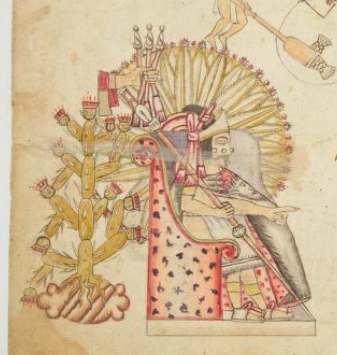Acamapichtli (Azca20)
This painted black-line drawing of the compound glyph for the personal name Acamapichtli shows a fist (mapichtli) full of reed (acatl) arrows. The left arm that has the fist at the end reaches in from the left. A bit of a garment shows on the arm, a two-tone tan and red checkered fabric. The hand is flesh-toned. The hand holds three arrows with their points upward and some fletching at the bottom. The tips are gray and white, while the shafts are red and white. The contextualizing image includes a profile portrait of Acamapichtli, sitting on a throne. He holds a scepter or staff of office that is segmented at the top and decorated with feathers in two places. He wears a diadem and the cape of a ruler. The cape (probably a tilmatli) seems to have a frontal view of the face of a divine force or anthropomorphic deity. Acamapichtli also gestures, pointing forward with the index finger of his left hand.
Stephanie Wood
The "ma" of Acamapichtli not only comes from the fist (mapichtli), but from the hand (maitl). It could also be read as "ma" for take, capture. The reeds are largely yellow, but with red ends and decorations of dark gray or brown eagle feathers and white down feathers, which is the version of acatl that coincides with the arrow (mitl). The phonetics of mitl do not enter into the name. We are calling this a glyph even lacking a gloss, being certain of its interpretation when based upon comparisons with other compound glyphs of this name. Normally, what are called iconographic examples in this digital collection are so labelled due to the lack of a confirming gloss. However, ideally, comparisons with glossed glyphs will help bear out the interpretations in such cases. Note the example of the Acamapichtli glyphs, below. Finally, the scepter partly obscured the three arrows, which we have reconstructed digitally.
Stephanie Wood
post-1550, possibly from the early seventeenth century.
Jeff Haskett-Wood
flechas, puños, nombres de hombres, nombres de gobernadores, tlatoani, tlatoque, mapilhuia, mahpilhuia
aca(tl), reeds, https://nahuatl.wired-humanities.org/content/acatl
mapich(tli), fist, https://nahuatl.wired-humanities.org/content/mapichtli
Acamapich(tli), first ruler of Tenochtitlan, https://nahuatl.wired-humanities.org/content/acamapichtli
ma(itl), hand or arm, https://nahuatl.wired-humanities.org/content/maitl
ma, take or capture, https://nahuatl.wired-humanities.org/content/ma-0
mi(tl), arrow, dart, https://nahuatl.wired-humanities.org/content/mitl
mapilhuia, to point a finger, https://nahuatl.wired-humanities.org/content/mapilhuia
Acamapichtli
Stephanie Wood
The Codex Azcatitlan is also known as the Histoire mexicaine, [Manuscrit] Mexicain 59–64. It is housed in the Bibliothèque Nationale de France, and hosted on line by the World Digital Library and the Library of Congress, which is “unaware of any copyright or other restrictions in the World Digital Library Collection.”
https://www.loc.gov/resource/gdcwdl.wdl_15280/?sp=20&st=image
The Library of Congress is “unaware of any copyright or other restrictions in the World Digital Library Collection.” But please cite Bibliothèque Nationale de France and this Visual Lexicon of Aztec Hieroglyphs.



